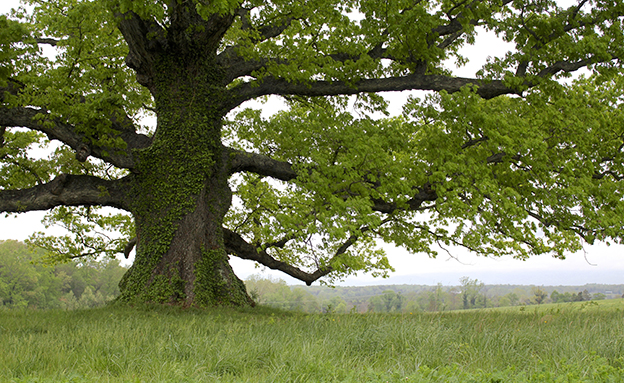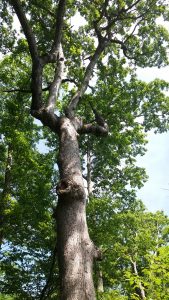“Virginia’s finest tree, period.”
By Pam Owen
A strong, graceful tree emblematic of Virginia forests, our native white oak (Quercus alba) also offers many important ecological services, including providing food and shelter to many types of wildlife. As one arborist is quoted in the book Remarkable Trees of Virginia, “White oaks are Virginia’s finest tree, period.”

The Earlysville Oak. By Steve Trumbull, C’ville Images
Growing from Maine to Florida and west to Texas and Minnesota, the white oak gets its name from its pale-gray bark and the pale underside of its leaf, which has rounded lobes distinguishable from those of other oaks. In autumn, the leaves’ surface color adds varied hues to the Piedmont’s famous leaf-color display.

White Oak along Limberlost Trail. By Pam Owen
Not only does the white oak provide us with shade, its wood, which is close-grained, heavy, strong, and hard with an attractive light-brown color, is prized in carpentry and woodworking. Cell outgrowths in this species can dam up vascular tissue, making the wood “highly watertight,” according to the Virginia Department of Forestry’s guide Common Native Trees of Virginia. For this reason, it’s valued for making barrels for whiskey and wine production and, in earlier times, for shipbuilding.
Remarkable Trees of Virginia, written by Jeff Kirwan and Nancy Ross Hugo, was the culmination of their project by the same name in which anyone could nominate trees they found remarkable. So many oaks were nominated, the authors write, that they gave this genus its own chapter in the book. And among the oaks, the white oaks “hogged the spotlight.” This is not surprising as, the authors note, white oaks “live the longest and therefore have the longest connections to Virginia’s people and landscapes,” and with their enormous trunks and wide-spreading crowns, they “most often achieve the classic form, shape, and size people expect of a remarkable tree.”
The two white oaks featured in the book are in Albemarle County (the “Earlysville Oak”) and Cumberland County. Another program that celebrates large trees is the Virginia Big Tree program, which uses several size parameters to score and rank candidates nominated by citizens. In the program’s online database, the Earlyville Oak is listed as the third-biggest white oak in Virginia. Two other northern Piedmont white oaks in Fairfax County are also in the species’ top five. The Earlyville Oak, with 396 points, is 75 feet tall, has a crown spread of 100 feet, and a trunk circumference of almost five feet.
The biggest white oak, which is in Brunswick County and believed to be more than 500 years old, scored 451 points. Like many trees, the most impressive white oaks usually achieve their size in open space, where plentiful sun and no competition allow them to grow and spread their crowns.
The white oak is also a boon to wildlife. As entomologist Doug Tallamy wrote in his award-winning book, Bringing Nature Home, oaks serve as preferred hosts for 534 species of butterflies and moths whose caterpillars feed on the foliage. Additionally, 90 percent of songbirds depend on caterpillars of these pollinators to feed their young.
In spring, the white oak literally casts its fate to the wind. The pollen of male flowers is released in the slightest breeze, which carries it to female flowers on the same tree and on other white oaks. Once pollinated, females begin producing another important food for wildlife—acorns.

By Pam Owen
“Acorns are a nutritious food providing protein, fat, and energy in the diets of 90 species of game and nongame animals in Virginia,” a Virginia Department of Game and Inland Fisheries (DGIF) blog post points out. Year-round wildlife residents—including bears, deer, squirrels and chipmunks, rabbits, opossums, wild turkeys, crows, blue jays, quail, raccoons, and wood ducks especially—depend on this “hard-mast” crop to get them through the winter. The white oak’s acorns are preferred over those of other oaks by many animals because of their high sugar content.
In 2015, acorn production crashed across Virginia and only rebounded last year. The red oak averaged higher crops overall, but in the Piedmont and Blue Ridge regions, the white oak beat out the red. White oaks can live 300–600 years and, even in decline, continue to benefit wildlife, offering cavities for nesting animals. A buffet of insects and mushrooms also consume the tree as its defenses give way in old age, and then they are consumed by their predators in turn. In fact, the “shii” in “shiitake” refers to trees that are relatives of our oaks, and the white oak is widely considered to be the best native tree on which to grow these popular mushrooms.
Landowners might well consider planting the native white oak instead of quicker-growing, shorter-lived, nonnative trees—they are likely to be rewarded more quickly than they think. As Tallamy notes, a planted oak acorn can grow “surprisingly fast … with a little pampering.” Even the slow-growing white oaks he planted on his property were “throwing some shade and creating their own little microhabitats” within five years.
Help conserve the White Oak
The Virginia Department of Forestry can help landowners manage and replace white oaks, including offering healthy seedlings for sale. Visit dof.virginia.gov, call (434) 977-6555, or contact your area forester for more information. The Virginia Native Plant Society, which discourages wild collecting of acorns, lists nurseries that propagate acorns for sale at vnps.org/conservation/plant-nurseries.
Leave a Reply